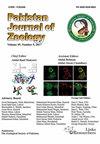Small Mammal Abundance and Forest Structure Changes by Different Post-Fire Silviculural Practices in Phou Khao Khauy National Protected Area, Lao PDR
IF 0.5
4区 生物学
Q4 ZOOLOGY
引用次数: 0
Abstract
We examined the abundance of five small rodent species, the chestnut white-bellied rat ( Niviventer fulvescens ), red spiny rat ( Maxomys surifer ), long-tailed giant rat ( Leopoldamys sabanus ), house mouse ( Mus musculus ), and black rat ( Rattus rattus ), and the stand structure of primary and secondary forest stands resulting from two types of post-fire silvicultural management practices in the Phou Khao Khauy National Protected Area (PKKNPA), Lao PDR. Post-fire silvicultural practices contributed to dramatically converting the structure of forests. Coverage of overstory, midstory, and ground vegetation, number of tree stems, woody seedlings, snags, and volume of coarse woody debris all had significant differences among study sites. We captured 456 individual small rodents during the dry and rainy seasons. The mean number of small rodents captured in primary forests was significantly higher than that in two secondary forests. In addition, there were more rodents in burned rice field stands than in burned rubber plantation stands. The value of overstory to understory vegetation coverage and the volume of coarse woody debris were strongly associated with small-mammal abundance in the PKKNPA. Thus, post-fire silvicultural practices should take the differences in small rodent abundance as well as forest structure into account. Long-term experiments may help illuminate the potential effects of management strategies after forest fires in the Lao PDR.老挝Phou Khao khay国家保护区火灾后不同造林方式对小型哺乳动物数量和森林结构的影响
研究了老挝Phou Khao khay国家保护区(PKKNPA)两种火灾后造林管理方式对5种小型啮齿动物(栗子白腹鼠(Niviventer fulvescens)、红刺鼠(Maxomys surifer)、长尾巨鼠(Leopoldamys sabanus)、家鼠(Mus musculus)和黑鼠(Rattus Rattus)的丰度以及原生林和次生林林分结构的影响。火灾后的造林实践极大地改变了森林的结构。在不同的研究点间,植被覆盖度、中层覆盖度和地面覆盖度、树干数量、木本幼苗数量、木本残块数量和粗木本残块体积均存在显著差异。在旱季和雨季共捕获小型啮齿动物456只。原始林捕获的小鼠类平均数量显著高于2个次生林。此外,稻田林分鼠类比橡胶林林分鼠类多。林下植被覆盖度和粗木屑体积与小哺乳动物的丰度密切相关。因此,火灾后的造林实践应考虑到小啮齿动物数量和森林结构的差异。长期实验可能有助于阐明老挝人民民主共和国森林火灾后管理战略的潜在影响。
本文章由计算机程序翻译,如有差异,请以英文原文为准。
求助全文
约1分钟内获得全文
求助全文
来源期刊

Pakistan Journal of Zoology
生物-动物学
CiteScore
1.10
自引率
16.70%
发文量
306
审稿时长
4.5 months
期刊介绍:
Pakistan Journal of Zoology (Pakistan J. Zool.) publishes original articles in English on all aspects of animal life. Generally these articles will be in, or related to one of the following subject areas: Physiology, Cell Biology, Molecular Biology, Genetics, Bioinformatics, Toxicology, Forensic Science, Developmental Biology, Entomology, Parasitology, Microbiology, Biotechnology, Pathology, Palaeontology. Taxonomy, Environmental Biology, Wildlife, Fisheries, Vertebrate and Invertebrate Morphology. Additionally, the journal considers research on health and clinical studies. Short communications are regularly considered, however, uninvited review articles, first records/reports of known species, case reports/studies and survey reports are not published in Pakistan Journal of Zoology.
 求助内容:
求助内容: 应助结果提醒方式:
应助结果提醒方式:


